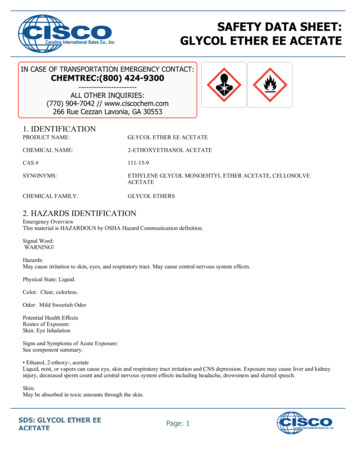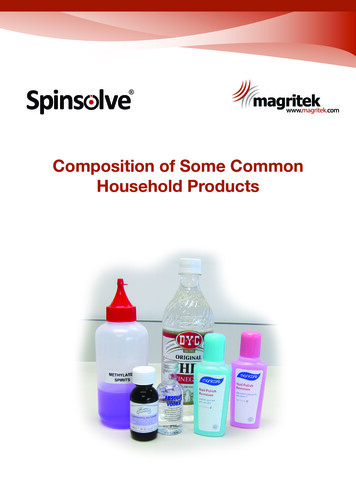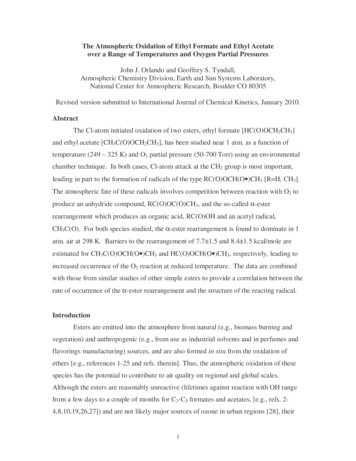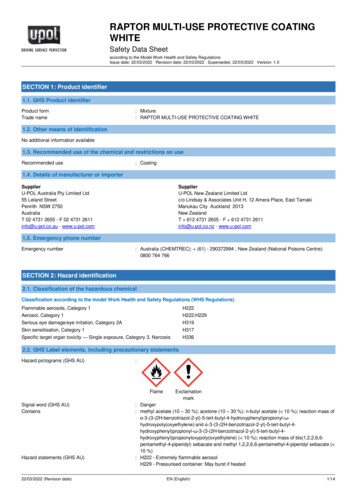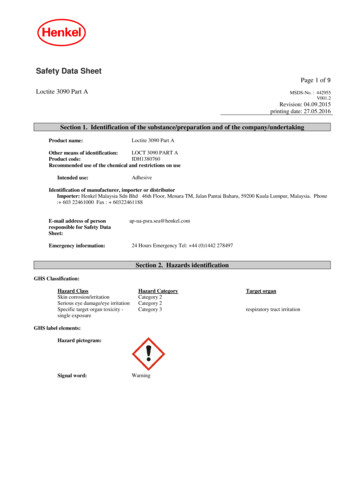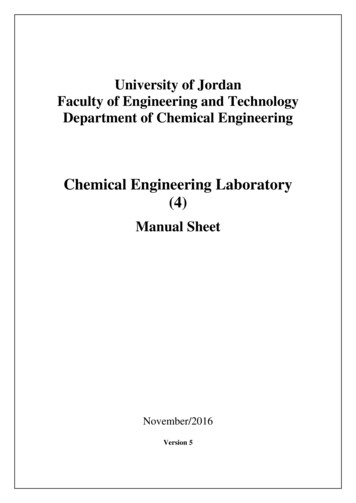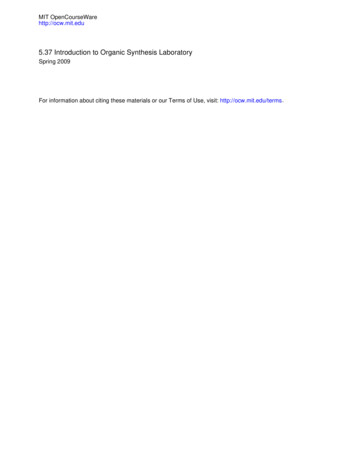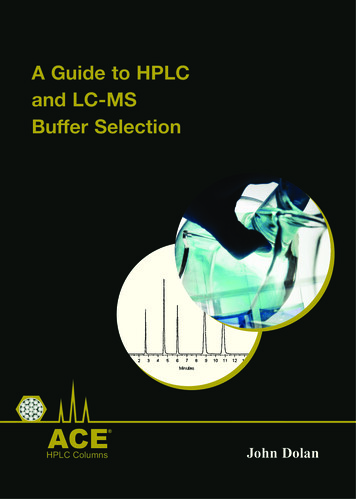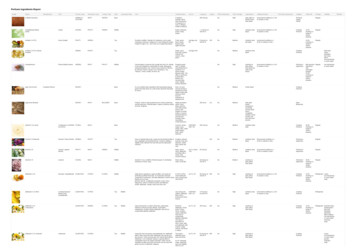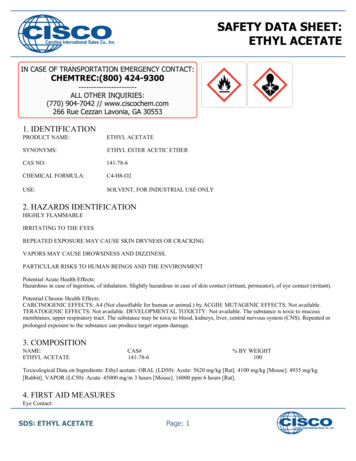
Transcription
SAFETY DATA SHEET:ETHYL ACETATEIN CASE OF TRANSPORTATION EMERGENCY CONTACT:CHEMTREC:(800) 424-9300----------------------ALL OTHER INQUIRIES:(770) 904-7042 // www.ciscochem.com266 Rue Cezzan Lavonia, GA 305531. IDENTIFICATIONPRODUCT NAME:ETHYL ACETATESYNONYMS:ETHYL ESTER ACETIC ETHERCAS NO:141-78-6CHEMICAL FORMULA:C4-H8-O2USE:SOLVENT, FOR INDUSTRIAL USE ONLY2. HAZARDS IDENTIFICATIONHIGHLY FLAMMABLEIRRITATING TO THE EYESREPEATED EXPOSURE MAY CAUSE SKIN DRYNESS OR CRACKINGVAPORS MAY CAUSE DROWSINESS AND DIZZINESS.PARTICULAR RISKS TO HUMAN BEINGS AND THE ENVIRONMENTPotential Acute Health Effects:Hazardous in case of ingestion, of inhalation. Slightly hazardous in case of skin contact (irritant, permeator), of eye contact (irritant).Potential Chronic Health Effects:CARCINOGENIC EFFECTS: A4 (Not classifiable for human or animal.) by ACGIH. MUTAGENIC EFFECTS: Not available.TERATOGENIC EFFECTS: Not available. DEVELOPMENTAL TOXICITY: Not available. The substance is toxic to mucousmembranes, upper respiratory tract. The substance may be toxic to blood, kidneys, liver, central nervous system (CNS). Repeated orprolonged exposure to the substance can produce target organs damage.3. COMPOSITIONNAME:ETHYL ACETATECAS#141-78-6% BY WEIGHT100Toxicological Data on Ingredients: Ethyl acetate: ORAL (LD50): Acute: 5620 mg/kg [Rat]. 4100 mg/kg [Mouse]. 4935 mg/kg[Rabbit]. VAPOR (LC50): Acute: 45000 mg/m 3 hours [Mouse]. 16000 ppm 6 hours [Rat].4. FIRST AID MEASURESEye Contact:SDS: ETHYL ACETATEPage: 1
Check for and remove any contact lenses. In case of contact, immediately flush eyes with plenty of water for at least 15 minutes.Cold water may be used. Get medical attention.Skin Contact:Wash with soap and water. Cover the irritated skin with an emollient. Get medical attention if irritation develops. Cold water may beused.Serious Skin Contact: Not available.Inhalation:If inhaled, remove to fresh air. If not breathing, give artificial respiration. If breathing is difficult, give oxygen. Get medical attentionif symptoms appear.Serious Inhalation:Evacuate the victim to a safe area as soon as possible. Loosen tight clothing such as a collar, tie, belt or waistband. If breathing isdifficult, administer oxygen. If the victim is not breathing, perform mouth-to-mouth resuscitation. Seek medical attention.Ingestion:Do NOT induce vomiting unless directed to do so by medical personnel. Never give anything by mouth to an unconscious person.Loosen tight clothing such as a collar, tie, belt or waistband. Get medical attention if symptoms appear.Serious Ingestion: Not available.5. FIRE FIGHTING MEASURESFlammability of the Product: Flammable.Auto-Ignition Temperature: 426.67 C (800 F)Flash Points: CLOSED CUP: -4.4 C (24.1 F). (TAG) OPEN CUP: 7.2 C (45 F) (Cleveland).Flammable Limits: LOWER: 2.2% UPPER: 9%Products of Combustion: These products are carbon oxides (CO, CO2).Fire Hazards in Presence of Various Substances:Highly flammable in presence of open flames and sparks, of heat. Slightly flammable to flammable in presence of oxidizingmaterials, of acids, of alkalis. Non-flammable in presence of shocks.Explosion Hazards in Presence of Various Substances:Risks of explosion of the product in presence of static discharge: Not available. Slightly explosive in presence of heat. Nonexplosive in presence of shocks.Fire Fighting Media and Instructions:Flammable liquid, soluble or dispersed in water. SMALL FIRE: Use DRY chemical powder. LARGE FIRE: Use alcohol foam,water spray or fog.Special Remarks on Fire Hazards:Vapor may travel considerable distance to source of ignition and flash back. When heated to decomposition it emits acrid smoke andirritating fumes.Special Remarks on Explosion Hazards:The liquid produces a vapor that forms explosive mixtures with air at normal temperatures. Explosive reaction with lithiumtetrahydroaluminate.6. ACCIDENTAL RELEASE MEASURESPersonal precautionsSDS: ETHYL ACETATEPage: 2
Keep people away from and upwind of spill/leak. Remove all sources of ignition. Do not breathe vapors or spray mist. Material cancreate slippery conditions.Environmental precautionsShould not be released into the environment. Prevent further leakage or spillage if safe to do so.Methods for cleaning upSoak up with inert absorbent material and dispose of as hazardous waste.7. HANDLING AND STORAGEPrecautions:Keep away from heat. Keep away from sources of ignition. Ground all equipment containing material. Do not ingest. Do not breathegas/fumes/ vapor/spray. Wear suitable protective clothing. In case of insufficient ventilation, wear suitable respiratory equipment. Ifingested, seek medical advice immediately and show the container or the label. Keep away from incompatibles such as oxidizingagents, acids, alkalis.Storage:Store in a segregated and approved area. Keep container in a cool, well-ventilated area. Keep container tightly closed and sealeduntil ready for use. Avoid all possible sources of ignition (spark or flame). Moisture sensitive.8. EXPOSURE CONTROLS AND PERSONAL PROECTIONEngineering Controls:Provide exhaust ventilation or other engineering controls to keep the airborne concentrations of vapors below their respectivethreshold limit value. Ensure that eyewash stations and safety showers are proximal to the work-station location.Personal Protection:Safety glasses. Lab coat. Vapor respirator. Be sure to use an approved/certified respirator or equivalent. Gloves.Personal Protection in Case of a Large Spill:Splash goggles. Full suit. Vapor respirator. Boots. Gloves. A self contained breathing apparatus should be used to avoid inhalation ofthe product. Suggested protective clothing might not be sufficient; consult a specialist BEFORE handling this product.Exposure Limits:TWA: 400 (ppm) from OSHA (PEL) [United States] TWA: 400 from ACGIH (TLV) [United States] TWA: 1400 (mg/m3) fromNIOSH [United States] TWA: 400 (ppm) from NIOSH [United States] TWA: 400 (ppm) [Canada] TWA: 1440 (mg/m3) [Canada]TWA: 1400 (mg/m3) from OSHA (PEL) [United States]3 Consult local authorities for acceptable exposure limits.9. PHYSICAL AND CHEMICAL PROPERTIESPhysical state and appearance: Liquid.Odor: Ethereal. Fruity. (Slight.)Taste: Bittersweet, wine-like burning tasteMolecular Weight: 88.11 g/moleColor: Colorless.pH (1% soln/water): Not available.Boiling Point: 77 C (170.6 F)Melting Point: -83 C (-117.4 F)Critical Temperature: 250 C (482 F)Specific Gravity: 0.902 (Water 1)SDS: ETHYL ACETATEPage: 3
Vapor Pressure: 12.4 kPa (@ 20 C)Vapor Density: 3.04 (Air 1)Volatility: Not available.Odor Threshold: 3.9 ppmWater/Oil Dist. Coeff.: The product is more soluble in oil; log(oil/water) 0.7Ionicity (in Water): Not available.Dispersion Properties: See solubility in water, diethyl ether, acetone.Solubility: Soluble in cold water, hot water, diethyl ether, acetone, alcohol, benzene.10. STABILITY AND REACTIVITYStability: The product is stable.Instability Temperature: Not available.Conditions of Instability: Heat, ignition sources (flames, sparks, static), incompatible materialsIncompatibility with various substances: Reactive with oxidizing agents, acids, alkalis.Corrosivity: Non-corrosive in presence of glass.Special Remarks on Reactivity:Also incompatible with nitrates, chlorosulfonic acid, oleum, potassium-tert-butoxide, and lithium tetrahydroaluminate. Moisturesensitive. On storage, it is slowly decomposed by water.Special Remarks on Corrosivity: Not available.Polymerization: Will not occur11. TOXICOLOGICAL INFORMATIONRoutes of Entry: Absorbed through skin. Eye contact. Inhalation. Ingestion.Toxicity to Animals:WARNING: THE LC50 VALUES HEREUNDER ARE ESTIMATED ON THE BASIS OF A 4-HOUR EXPOSURE. Acute oraltoxicity (LD50): 4100 mg/kg [Mouse]. Acute toxicity of the vapor (LC50): 45000 mg/m3 3 hours [Mouse].Chronic Effects on Humans:CARCINOGENIC EFFECTS: A4 (Not classifiable for human or animal.) by ACGIH. Causes damage to the following organs:mucous membranes, upper respiratory tract. May cause damage to the following organs: blood, kidneys, liver, central nervoussystem (CNS).Other Toxic Effects on Humans:Hazardous in case of ingestion, of inhalation. Slightly hazardous in case of skin contact (irritant, permeator).Special Remarks on Toxicity to Animals: LD50 [Rabbit] - Route: skin; Dose 20,000 ml/kgSpecial Remarks on Chronic Effects on Humans:May affect genetic material (mutagenic). May cause adverse reproductive effects. based on animal test data. No human data found atthis time.Special Remarks on other Toxic Effects on Humans:Acute Potential Health Effects: Skin: May cause skin irritation. Eyes: Causes eye irritation. May cause irritation of the conjunctivia.Inhalation: May cause respiratory tract and mucous membrane irritation. May affect respiration and may cause acute pulmonarySDS: ETHYL ACETATEPage: 4
edema. May affect gastrointestinal tract (nausea, vomiting). May affect behavior/central nervous system (mild central nervoussystem depression - exhilaration, talkativeness, boastfulness, belligerancy, vertigo, diplopia, drowsiness, slurred speech, slowedreaction time, dizziness, lightheadedness, somnolence, ataxia, unconciousness, irritability, fatigue, sleep disturbances, reducedmemory and concentration, stupor, coma), cardiovascular system (peripheral vascular collapse (shock) - rapid pulse, hypotension,cold pale skin, hypothermia). Other symptoms may include: flushing of face and sweating.Ingestion: May cause gastrointestinal tractirritation with nausea and vomiting. May affect blood, behavior/central nervous system (CNS depression - effects may be similar tothat of inhalation). Chronic Potential Health Effects: Skin: Repeated or prolonged skin contact may cause drying and cracking of theskin. IngestIon: Prolonged or repeated ingestion may affectthe liver. Inhalation: Prolonged inhalation may affect behavior/central nervous system (symptoms similar to those of acuteinhalation), and cause liver, kidney, lung, and heart damage. It may also affect metabolism, and blood (anemia, leukocytosis).12. ECOLOGICAL INFORMATIONEcotoxicity:Ecotoxicity in water (LC50): 220 mg/l 96 hours [Fish (Fathead minnow)]. 212.5 ppm 96 hours [Fish (Indian catfish)].BOD5 and COD: Not available.Products of Biodegradation:Possibly hazardous short term degradation products are not likely. However, long term degradation products may arise.Toxicity of the Products of Biodegradation: The product itself and its products of degradation are not toxic.Special Remarks on the Products of Biodegradation: Not available.13. DISPOSAL CONSIDERATIONSProductIn accordance with local and national regulations., Do not contaminate ponds, waterways or ditches with chemical or usedcontainer., The product should not be allowed to enter drains, water courses or the soil.Contaminated packagingDo not burn, or use a cutting torch on, the empty drum. Triple rinse containers. Can be offered for recycling, re-conditioning orpuncture.14. TRANSPORT INFORMATIONDOT Classification: CLASS 3: Flammable liquid.Identification: : Ethyl Acetate UNNA: 1173 PG: IISpecial Provisions for Transport: Not available.15. REGULATORY INFORMATIONFederal and State Regulations:Connecticut hazardous material survey.: Ethyl acetate Illinois toxic substances disclosure to employee act: Ethyl acetate Illinoischemical safety act: Ethyl acetate New York release reporting list: Ethyl acetate Rhode Island RTK hazardous substances: Ethylacetate Pennsylvania RTK: Ethyl acetate Florida: Ethyl acetate Minnesota: Ethyl acetate Massachusetts RTK: Ethyl acetateMassachusetts spill list: Ethyl acetate New Jersey: Ethyl acetate New Jersey spill list: Ethyl acetate Louisiana spill reporting: Ethylacetate California Director's list of Hazardous Substances: Ethyl acetate TSCA 8(b) inventory: Ethyl acetate TSCA 4(a) final testrules: Ethyl acetate TSCA 8(a) IUR: Ethyl acetate TSCA 12(b) annual export notification: Ethyl acetate CERCLA: Hazardoussubstances.: Ethyl acetate: 5000 lbs. (2268 kg)Other Regulations:OSHA: Hazardous by definition of Hazard Communication Standard (29 CFR 1910.1200). EINECS: This product is on theEuropean Inventory of Existing Commercial Chemical Substances.Other Classifications:WHMIS (Canada): CLASS B-2: Flammable liquid with a flash point lower than 37.8 C (100 F).SDS: ETHYL ACETATEPage: 5
DSCL (EEC):R11- Highly flammable. R36- Irritating to eyes. S2- Keep out of the reach of children. S16- Keep away from sources of ignition - Nosmoking. S26- In case of contact with eyes, rinse immediately with plenty of water and seek medical advice. S33Take precautionary measures against static discharges. S46- If swallowed, seek medical advice immediately and show this containeror label.HMIS (U.S.A.):Health Hazard: 2Fire Hazard: 3Reactivity: 0Personal Protection: gNational Fire Protection Association (U.S.A.):Health: 1Flammability: 3Reactivity: 0Specific hazard:Protective Equipment:Gloves. Lab coat. Vapor respirator. Be sure to use an approved/certified respirator or equivalent. Wear appropriate respirator whenventilation is inadequate. Safety glasses.16. OTHER INFORMATIONThe information above is believed to be accurate and represents the best information currently available to us. However, we make nowarranty of merchantability or any other warranty, express or implied, with respect to such information, and we assume no liabilityresulting from its use. Users should make their own investigations to determine the suitability of the information for their particularpurposes. In no event shall CISCO be liable for any claims, losses, or damages of any third party or for lost profits or any special,indirect, incidental, consequential or exemplary damages, howsoever arising, even if CISCO has been advised of the possibility ofsuch damages.Date Created: 7/13/2015Date Updated: 7/13/2015SDS: ETHYL ACETATEPage: 6
Toxicological Data on Ingredients: Ethyl acetate: ORAL (LD50): Acute: 5620 mg/kg [Rat]. 4100 mg/kg [Mouse]. 4935 mg/kg [Rabbit]. VAPOR (LC50): Acute: 45000 mg/m 3 hours [Mouse]. 16000 ppm 6 hours [Rat]. . These products are carbon oxides (CO, CO2). Fire Hazards in Presence of Various Substances: Highly flammable in presence of open flames and .
